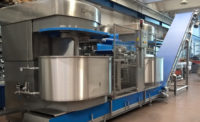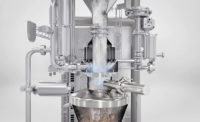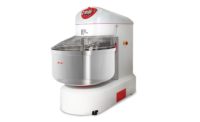Snack and bakery companies want mixers that are easier to program and control, simpler to clean, more energy efficient, and well-tailored to their particular applications—and they expect equipment manufacturers to consult with them upfront to find the best fit.
Top features
Customers of Koenig Bakery Systems, Ashland, VA, typically want to provide a general sense of the products that will run on the line and the conditions in their bakery, and then they work with Koenig to gain recommendations about the type of mixer, temperature of ingredients, mixing time and resting time to produce optimized dough, says Richard Breeswine, CEO.
“We also have other customers who are concerned about mixing their doughs for too long, such as for ciabatta doughs with high dough yield,” says Breeswine. “We are consulting with customers often nowadays about mixing their doughs properly, so the best results are obtained.”
Ken Langhorn, technical director, Charles Ross & Son Co., Hauppauge, NY, says the ability to easily clean the mixer is often a high priority for customers. “Construction details are often manipulated based on how a customer is looking to clean,” he says. “You might have radius-to-corners instead of a 90° edge, or a sealing arrangement on a product shaft to keep contaminants out.”
Customers of AMF Canada, Sherbrooke, Quebec, tend to appreciate easy sanitation more than fancier features, says Bobby Martin, director of conveying, engineering systems. “I know there are bells and whistles out there, things that are promoted to take advantage, but something that doesn’t make any difference in mixing, we don’t do,” he says. “The sanitation aspect is definitely a value we bring on the market that customers may appreciate, more than the bells and whistles.”
Stephen Bloom, vice president and co-owner, Allied Bakery Equipment, Santa Fe Springs, CA, which represents the Italian firm San Cassiano, says his customers are looking for many of the same qualities they always have—but with one more-recent addition to the mix.
“Customers are constantly looking for easier to clean, better sanitation, better programmability, electronic control over what’s going on, and, more and more, even in this country, more energy savings,” says Bloom. “This is something we’re trying to push. With mixers being made in Europe, this is more of a hot topic because energy is so much more expensive. People will justify the cost by the energy savings more than here. But the biggest companies here are aware of it.”
New and updated equipment
AMF recently released the Open Frame Mixer, designed to be easy to clean and easy to maintain, with a round tubular offset frame design made from stainless steel, Martin says. The mixer provides a triple bar agitator for doughs that need to develop and a sigma arm for those that need to be blended, such as for cookie or pie doughs, says Jacques Nedeau, sales coordinator.
AMF provides a wide range of mixer capacities, handling between 150 and 4,000 pans, depending on the dough style, Martin says. Some, like a recent installation in Brazil, are manual, while others in the U.S. and Europe are automated.
Martin notes that AMF takes the time to ask questions to understand the environment where the mixer will be installed. The company also fine-tunes installations to offer application-friendly adjustments. “We make sure we have the dry ingredients’ entry points well laid out on the top,” he says. “Bread dough would be a different environment from a cookie doughs in the way it’s loaded, and the way it’s delivered downstream.”
Allied Bakery focuses mostly on two machines developed by San Cassiano, Bloom notes. The first, called the Revo, is a twin-tool—but not spiral—mixer that comes in sizes ranging from very small to “super industrial,” he says. Originally designed for cookies, the Revo has worked exceptionally well for the gluten-free market because the mix time is shortened by the double tool, which also lets operators effectively scrape the bowl, he adds. “So many gluten-free batters are sticky and can create inconsistencies if not immediately reincorporated.”
The Revo provides the ability to rotate tools clockwise and counterclockwise at will, the speeds are controlled by an inverter, and it can be fully washed down to shorten the downtime between changeovers, Bloom says.
The other San Cassiano mixer, called the Kryos, was developed to address what Bloom terms “the Achilles heel of vertical mixers: how you jacket and cool a rotating bowl.” Instead of dry ice, the Kryos uses glycol to attain a better temperature control and shorter mixing times compared to horizontal mixers, he says. “You’re able to increase the hydration up to 3 to 5 percent more water depending on the flour you’re using. You have flexibility in batch size. It’s much easier to maintain and clean. And there’s way, way less energy consumption.”
The Kryos can be used for white and other loaf breads, as well as croissant dough, and Allied believes it could prove useful for the tortilla market. Like all of the machines from San Cassiano, it provides the ability to record energy used in lieu of time to measure proper dough consistency. “If you know how much energy you’re supposed to have used, and there’s a big variation, you know something’s wrong,” he says. “Somebody forgot to put in water, or they used too much flour. It’s a good way to make sure the product doesn’t go any further in the system.”
Zeppelin Systems USA, Odessa, FL, focuses entirely on continuous rather than batch mixing and does not handle bowl or horizontal mixers, says Stephen Marquardt, sales director, food. Of late, Zeppelin has changed the Codos double-screw continuous mixer to bring about a more-hygienic design with a wash-in-place lid. “You can clean the mixer right in place,” he says. “You don’t have to dismantle it, take it out and move it.”
Zeppelin also has added the DymoMix prehydration unit that’s used with ingredients like cream, yeast, vinegar and sugar to prehydrate and preblend raw materials before they enter continuous mixing, which tremendously reduces the mix time and increases hydration, notes Marquardt. “There are energy cost savings, of course, as well as raw materials.” It’s used in applications like snack biscuits and sandwich-style cookies.
Speed is the key ingredient in the Tweedy mixer from Baker Perkins, Peterborough, England, leading to reduced costs and improved consistency and quality, the company says. The Tweedy mixes a batch of dough in three minutes, weighing the next batch at the same time, which can lead to as many as 14 batches per hour, between 375 and 850 pounds. Small batch sizes means processing happens quickly enough that fermentation is minimized, which helps achieve accurate weight control and consistent texture, with little waste.
The Tweedy produces high-quality dough with lower-quality flour due to the thoroughness of the mixing, the company says. The mixer can produce a wide range of textures, which means the Tweedy is used for close-grained pan bread and artisan-style loaves, including white, whole wheat, mixed rye, whole grain or multigrain. It’s also used in applications such as burger buns, pizza crusts, pastries and cakes.
Koenig has released the Twin Twist Mixer DW 240, which features a hygienic design consistent with other Koenig machines, wash-down capability with low-pressure water, completely sealed and welded stainless steel construction, and easily accessible coverings for cleaning and maintenance.
The Twin Twist is especially suited to wheat and pastry doughs, but also works well for rye and rye wheat. The new model’s first installation went into the Fireking Baking Co. facility in Braintree, MA, mixing dough for its bread and buns.
Rapidojet takes a unique approach toward mixing. Its continuous hydration mixing system is suited to production of a wide range of baked goods, including bread, buns and rolls, cakes and sweet goods.
Bakers can also use Rapidojet to enhance water absorption of intact grains, accelerating water migration through the outer layer of the grain. This also applies to processes for sprouting grain.
The mixer’s benefits include 5 percent to 8 percent higher yield due to high-pressure hydration, a reduction in mixing time due to the higher pressure instantly creating gluten structure, and a significant reduction in glycol or ice due to lower mix time and less friction, says Ken Schwenger, president, Bakery Concepts International, Enola, PA, Rapidojet’s U.S. representative. Other potential benefits include reduced yeast and conditioner use (also due to reduced mix time) and a longer shelf life due to slower starch retrogradation.
Rapidojet technology can also aid gluten-free mixing processes, eliminating the need to presoak flakes and seeds while yielding a lump-free dough.
Charles Ross offers the VersaMix Multi-Shaft Mixer for mixing pastes, creams and gel-type products. The company says the mixer provides capabilities like powder dispersion, emulsification, dissolution, homogenization, and heating and cooling, all achieved in a closed system without any transfer steps.
Ross Multi-Shaft Mixers come in numerous models, with capacities ranging from 1 through 4,000 gallons. They feature stainless steel product contact surfaces, multiple ports for raw materials, a vacuum/pressure transmitter, a thermoprobe and a tank light. “We tailor our equipment to the customer’s needs,” Langhorn says.










